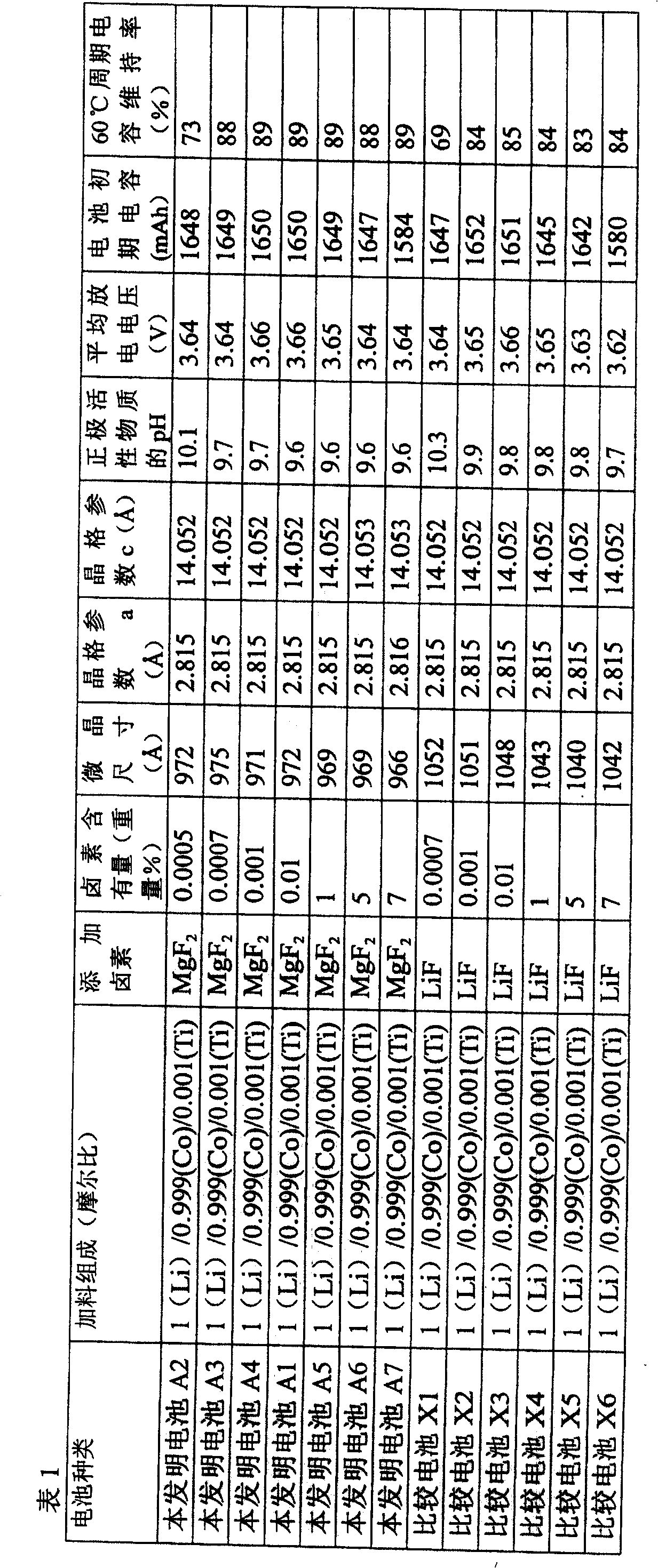Nonaqueous electrolyte secondary battery and producing method thereof
一种非水电解质、二次电池的技术,应用在非水电解质蓄电池、二次电池、电池电极等方向,能够解决电池电容下降等问题
- Summary
- Abstract
- Description
- Claims
- Application Information
AI Technical Summary
Problems solved by technology
Method used
Image
Examples
preparation example Construction
[0018] (Preparation of positive electrode)
[0019] As the starting material, lithium carbonate (Li 2 CO 3 ) As a lithium source, (Co 0.999 V 0.001 ) 3 o 4 as a source of cobalt. The cobalt and vanadium dissolved in the acid solution are precipitated in the form of composite hydroxide, and then calcined at 300°C to obtain a substance composed of vanadium composite tricobalt tetroxide. Next, weigh lithium carbonate and the material formed by compounding tricobalt tetroxide with vanadium, so that the Li / (Co+V) molar ratio therein reaches 1, and then add MgF 2 , making the fluorine content 0.01% by weight with respect to the total amount of positive electrode active materials, and mixing these compounds. Afterwards, the mixture was calcined under air conditions to obtain hexagonal LiCo containing fluorine and magnesium. 0.999 V 0.001 o 2 The calcined body was then pulverized with a mortar to an average particle size of 10 μm as a positive electrode active material.
[...
Embodiment 1
[0033] In Example 1, a battery prepared in the same manner as described in the above-described embodiment of the invention was used.
[0034] The battery thus produced is referred to as Inventive Battery A1.
Embodiment 2~7
[0036] In addition to setting the halogen (fluorine) content relative to the total amount of positive electrode active materials as 0.0005% by weight, 0.0007% by weight, 0.001% by weight, 1% by weight, 5% by weight, and 7% by weight, it is used in the implementation The same method as Example 1 was used to prepare the battery.
[0037] The batteries thus prepared are respectively referred to as batteries A2 to A7 of the present invention.
PUM
| Property | Measurement | Unit |
|---|---|---|
| particle diameter | aaaaa | aaaaa |
| aperture size | aaaaa | aaaaa |
Abstract
Description
Claims
Application Information
 Login to View More
Login to View More - R&D
- Intellectual Property
- Life Sciences
- Materials
- Tech Scout
- Unparalleled Data Quality
- Higher Quality Content
- 60% Fewer Hallucinations
Browse by: Latest US Patents, China's latest patents, Technical Efficacy Thesaurus, Application Domain, Technology Topic, Popular Technical Reports.
© 2025 PatSnap. All rights reserved.Legal|Privacy policy|Modern Slavery Act Transparency Statement|Sitemap|About US| Contact US: help@patsnap.com

